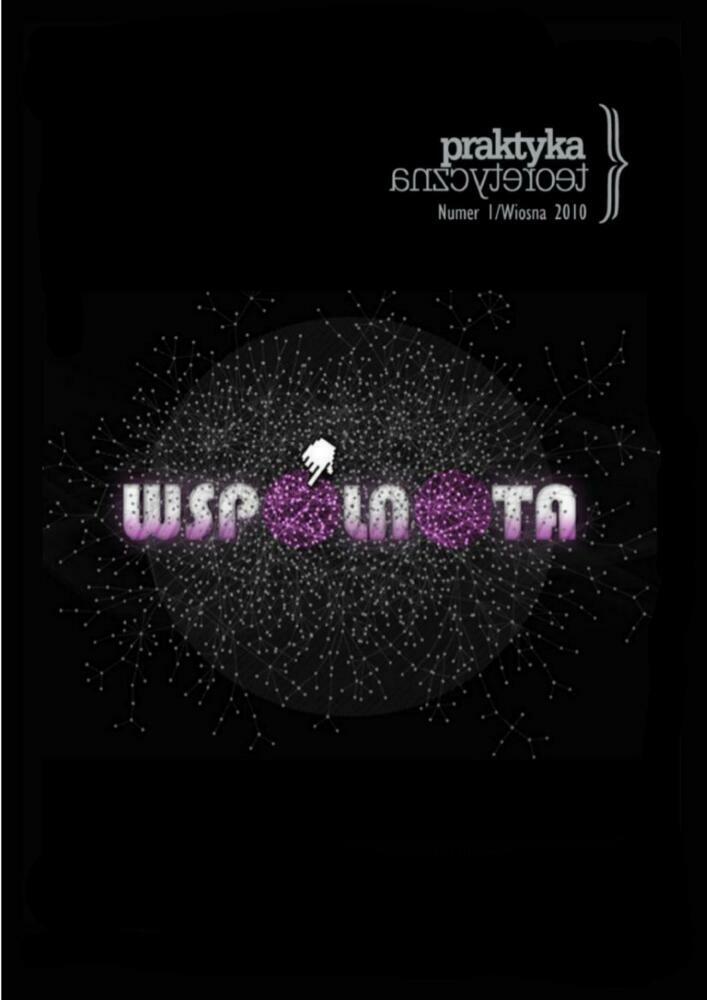Abstract
The article concentrates on the community issues in Krzysztof Wodiczko’s art. It analyzes one of his latest projects, “Poznan Projection” (the effect of artist’s cooperation with homeless people from “Social Emergency”), in reference to selected philosophical community theories, signed by Jacques Rancière, Jean-Luc Nancy, Julia Kristeva or Jacques Derrida. Author argues that communal character of Wodiczko’s latest works is a consequence of changes in his artistic attitude, passage “from the symbolic and critical politics to the ethical and therapeutic political” (Andrzej Turowski).
The text consists of three parts. The first part briefly presents community art as a specific field of public art. The focus is on the ethical dilemmas characteristic for this kind of artistic production. Next part is dedicated to Wodiczko’s vision of community and its articulation in “Poznan Projection”. In the last part of the article, “Poznan Projection” is being confronted with Rancière’s concept of “distribution of the sensible” and Victor Turner’s theory of communitas. Author argues that while most of Wodiczko’s works can be read as political articulation of equality (therefore foundation for a new distribution of the sensible), “Poznan Projection” failed to establish a valid relationship between the “little” community of the homeless and the “big” urban collective.
References
Bauman Z. 2008. Wspólnota. W poszukiwaniu bezpieczeństwa w niepewnym świecie. Kraków: Wydawnictwo Literackie.
Cohen-Cruz. 2009. An Introduction to Community Art and Activism. http://www.communityarts.net/readingroom /archivefiles/2002/02/an_introduction.pl
Delanty G. 2006. Community. London-New York: Routledge.
Derrida J. 2007. Hostipitality. W Jacques Derrida: Basic Writings. London-New York: Routledge.
Deutsche R. 2002. “Agorafobia”. Artium Questiones. 13 : 295-357.
Freud Z. 1997. Niesamowite. W Pisma psychologiczne. Warszawa: Wydawnictwo KR.
Goldbard A. 2006. New Creative Community. The Art of Cultural Development. Oakland: New Village Press.
Held K. 2003. Fenomenologia świata politycznego. Warszawa: Wydawnictwo IFiS PAN.
Hollier D. 1995. Gdy miasto śpi. W Sztuka publiczna. Warszawa: Centrum Sztuki Współczesnej.
Kester G. H. 2004. Conversation Pieces. Community + Communication in Modern Art. Berkeley-Los Angeles: University of California Press.
Krajewski M. 2005. „Co to jest sztuka publiczna? ”. Kultura i Społeczeństwo 74 (1) : 57-78.
Kristeva J. 1991. Strangers to Ourselves. New York: Columbia University Press.
Kwon M. 2004. One Place after Another. Site-specific Art and Locational Identity. Cambridge: The MIT Press.
Nancy J. 1991. The Inoperative Community. Minneapolis.
North M. 1997. Sfera publiczna jako rzeźba. Od Civitas Dei do ornamentu z ludzkiej masy. W Pisanie miasta - czytanie miasta. Poznań: Fundacja Humaniora.
Rancière J. 2007. Dzielenie postrzegalnego. Estetyka i polityka. Kraków: Korporacja Ha!art.
Rancière J. 2008. Na brzegach politycznego. Kraków: Korporacja Ha!art.
Rejniak-Majewska A. 2008. „Ciężar doświadczenia i próżnia przestrzeni miejskiej. Wokół „Tilted Arc” Richarda Serry”. Przegląd Kulturoznawczy 4 (1) : 120-132.
Sławek T. 1997. Jacques Derrida: dekonstrukcje i etyka gościnności. W Jacques Derrida. Doctor honoris causa Universitatis Silesiensis. Katowice: Wydawnictwo Uniwersytetu Śląskiego.
Sławek T. 2008. Słowo wstępne. W Dystans i zaangażowanie. Wspólnota – literatura – doświadczenie. Antologia przekładów. Katowice: Wydawnictwo Uniwersytetu Śląskiego.
Taborska H. 1996. Współczesna sztuka publiczna. Dzieła i problemy. Warszawa: Wiedza i Życie.
Turner V. 2006. Liminalność i communitas. W Badanie kultury: elementy teorii antropologicznej. Kontynuacje. Warszawa: Wydawnictwo Naukowe PWN.
Turowski A. 2005. Przemieszczenia i obrazy dialektyczne Krzysztofa Wodiczki. W Krzysztof Wodliczko. Pomnikoterapia. Warszawa: Zachęta Narodowa Galeria Sztuki.
Wodiczko K. 1995. Wstępem jest rozmowa. Piotr Rypson i Adam Szymczyk rozmawiają z Krzysztofem Wodiczką. W K. Wodiczko. Sztuka publiczna. Warszawa.
Wodiczko K. 2007. Miasto. demokracja i sztuka. W Krzysztof Wodiczko. Doktor honoris causa Akademii Sztuk Pięknych w Poznaniu. Poznań.
Žižek S. 2001. „Melancholia i akt etyczny”. Res Publica Nowa 10.
License
“Theoretical Practice” seeks to put into practice the idea of open access to knowledge and broadening the domain of the commons. It serves the development of science, thinking and critical reflection. The journal is published in open-access mode under the CC-BY-NC-SA 4.0 license (detail available here: http://creativecommons.org/licenses/by-nc-sa/4.0/). Articles published in the journal may be freely distributed, stored, printed and utilized for academic and teaching purposes without restrictions.
They should not be, however, used for any commercial purposes or be reconstructed into derivative creations. Access to the journal may not be limited or offered for a fee by any third party.
Prospective authors are obliged to fill in, sign and send back the publishing contract compliant with the CC licencing. [PL.pdf, PL.doc, EN.pdf,EN.doc].
According to this contract, authors grant the journal a non-exclusive right to publish their work under the creative commons license (CC-BY-NC-SA 4.0) without any financial obligation on both sides of the contract.
Before submission authors should make sure that derivative materials they use are not protected by copyright preventing their non-commercial publication. Authors are responsible for any respective copyright violations.
